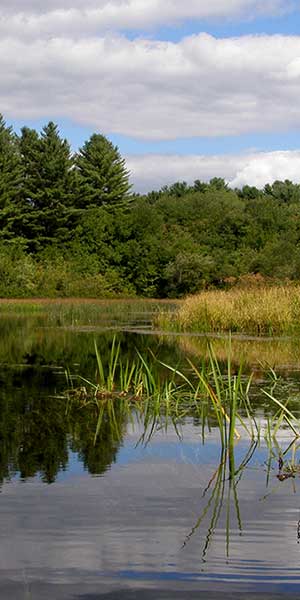
Wood-Pawcatuck Wild and Scenic Rivers
Welcome! In March 2019, after thousands of hours of community effort over a ten year period, Rhode Island and eastern Connecticut residents celebrated the Wood-Pawcatuck Watershed receiving a National Wild and Scenic River designation. The watershed is now considered a Partnership Wild and Scenic Rivers System under the federal Wild and Scenic Rivers Act. Less than 1% of the 3.6 million miles of streams in the U.S can claim this designation!
The Wild and Scenic Rivers Act was enacted as a way to protect and preserve certain rivers with outstanding natural, cultural, and recreational values for the enjoyment of present and future generations. The Wood-Pawcatuck Watershed’s 300 square mile area includes seven major rivers as well as countless lakes, wetlands, and smaller streams. Although Rhode Island may be the smallest state and the second most densely populated state in the union, a total of 110 river miles within this watershed were found to be eligible for this prestigious recognition and protection!
Our Mission
A Stewardship Council was established in early 2019 with representatives from the twelve towns in the watershed, along with state agencies and other non-profit conservation organizations. The Council’s mission is to help preserve, protect and enhance the special environmental, cultural, and recreational values of the Wood-Pawcatuck Watershed and its Wild and Scenic Rivers and tributaries in Rhode Island and Connecticut for the benefit and enjoyment of present and future generations.
Our Goals are...
- Improve and conserve water quality and water quantity.
- Conserve open space, woodlands, wetlands & geologic features.
- Protect native plant and animal species.
- Preserve cultural, historical and archaeological sites.
- Enhance outdoor recreation opportunities.
- Encourage environmental education and watershed awareness.
So what makes the Wood-Pawcatuck Watershed so special?
- 24 miles of ‘wild’ river segments – the second most ‘wild’ miles of any Partnership Wild and Scenic River System in the US
- The longest Wild and Scenic River System in New England with 110 miles
- 87% of the land is undeveloped or in agriculture and about 75% is forested land
- 75% of all animal species found in RI occur within this watershed
- 70% of globally rare and 63% of RI’s rare species and natural community occurrences are found within this watershed
- The darkest sky region between Washington DC and Boston
- Unique geological features such as the Green Fall Rift Valley and Charlestown Moraine
- Exceptional ecosystems such as:
- Upper Wood River which supports the highest variety of plants and animals of any river in New England
- Beaver River which is 91% undeveloped and provides clean, cold habitat that supports a large number of invertebrate species
- Pawcatuck River system has been identified by the Nature Conservancy as one of the best examples of intact riverine habitat in the Lower New England ecoregion
- Green Fall-Ashaway River lies within one of the largest contiguous forests in southern New England and supports an exceptional number and variety of birds
- Bell Cedar Swamp contains critical Atlantic White Cedar stands and other imperiled natural habitats that support endangered, rare and uncommon plants
- Chipuxet River is within the Great Swamp, which is designated as a National Natural Landmark
- Queen-Usquepaugh River supports a high biodiversity, especially dragonflies, mussels, brook trout and amphibians
- Shunock River supports populations of alewife and blueback herring, sea-run trout and American eel
- Water from five of the rivers powered historic mills, remains of which can be seen along the river banks
- Tribal camping/fishing/settlements of the Pequot and Eastern Pequot Tribes have been documented along the Shunock River while the Mohegan and Narragansett Tribes used the upper Wood River for winter camps
- 34 miles of the Pawcatuck River and 24 miles of the Wood River are exceptional scenic canoeing and kayaking areas
- All seven of the rivers and surrounding areas support a variety of recreational activities such as swimming, canoeing, fishing, hiking, hunting, horseback riding, mountain biking and public boat launches
See one or all of The Wild and Scenic Rivers pages for a description of each River’s Outstandingly Remarkable Values!




